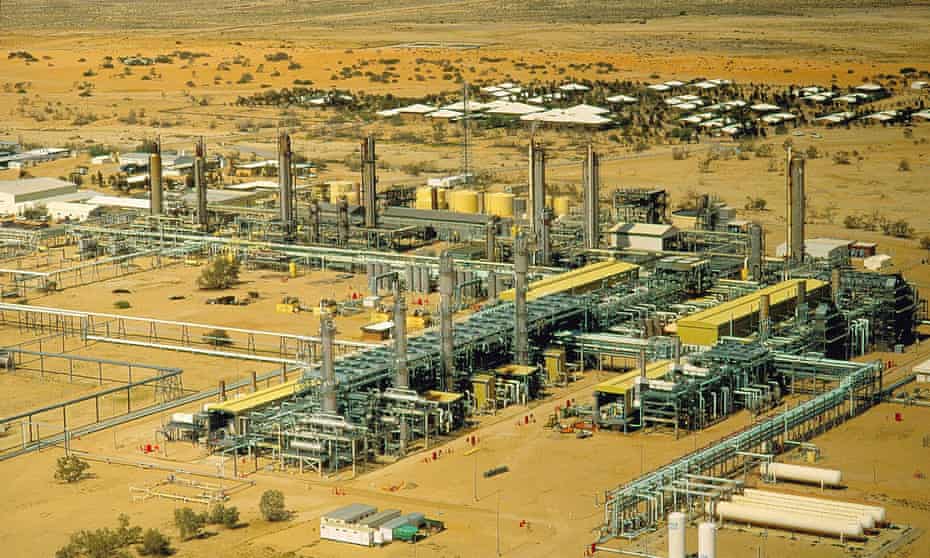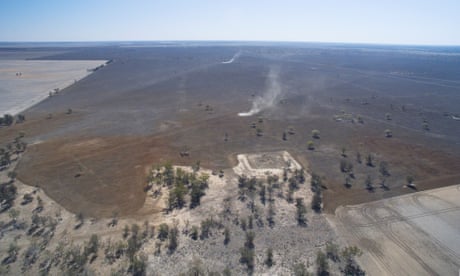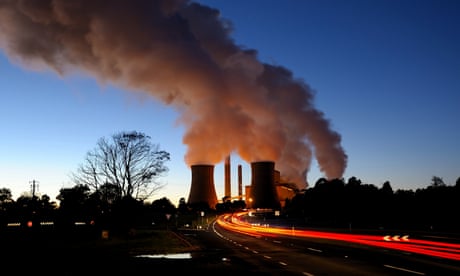'MAYBE' TECH
Can Moomba live up to the hype? Santos’ $220m carbon capture storage project
The first project registered for the government’s CCS carbon credits program is also claimed to be one of the world’s biggest

The first project registered for the government’s CCS carbon credits program is also claimed to be one of the world’s biggest

A model of Santos’ Moomba carbon capture storage project was on display in the Australian government’s pavilion at Cop26.
Photograph: Santos Ltd/PR IMAGE
Supported by
.png) A
A
Graham Readfearn
@readfearn
Mon 8 Nov 2021 16.30 GMT
About 800km north of Adelaide in the middle of the South Australia desert, an oil and gas company is working on a high-profile project to capture and store carbon dioxide.
It’s claimed to be one of the world’s biggest carbon capture projects and lauded by the federal government, but what is actually going on at Moomba?
Can this $220m project led by Santos really live up to the hype and will it store enough CO2 to make a difference?
Supported by
.png) A
AGraham Readfearn
@readfearn
Mon 8 Nov 2021 16.30 GMT
About 800km north of Adelaide in the middle of the South Australia desert, an oil and gas company is working on a high-profile project to capture and store carbon dioxide.
It’s claimed to be one of the world’s biggest carbon capture projects and lauded by the federal government, but what is actually going on at Moomba?
Can this $220m project led by Santos really live up to the hype and will it store enough CO2 to make a difference?
What’s the hype?
The Santos chief executive, Kevin Gallagher, travelled to Glasgow for the start of the international climate talks to stand alongside Australia’s emissions reduction minister, Angus Taylor, and confirm the company’s investment in the project.
Gallagher said: “This carbon reduction project in the South Australian outback will be one of the biggest and lowest cost in the world and will safely and permanently store 1.7m tonnes of carbon dioxide per year in the same reservoirs that held oil and gas in place for tens of millions of years.”
The project is the first carbon capture and storage scheme to be registered as eligible to generate carbon credits under the Morrison government’s emissions reduction fund (ERF).
A model of the project was on display at the government’s pavilion during the first days of the Cop26 climate talks.
How will it work?
According to an environmental report submitted to the South Australian government in March, Santos will look to capture CO2 currently being vented to the atmosphere from its existing gas plant at Moomba.
That gas will be compressed and transported through new or existing pipelines “to suitable locations where it will be injected into target geological formations deep underground”.

Australia’s emissions from land clearing likely far higher than claimed, analysis indicates
Last year, the company told an industry roundtable it had identified six sites up to 60km away from Moomba that could be used for CO2 storage. Santos has said in the future it could store CO2 from other sources and third parties.
Will the project actually cut emissions?
Santos claims Moomba will be one of the world’s largest CCS projects and will store 1.7m tonnes of CO2-equivalent a year with the potential to scale up to 20m tonnes a year.
For context, 1.7m tonnes of CO2 is about 0.35% of Australia’s current annual emissions of 494.2m tonnes.
Operators of Australia’s biggest CCS scheme, Gorgon Carbon Dioxide Injection project, off the north-west coast of WA, say it can store 4m tonnes of CO2 a year but has missed targets.
According to Santos’ latest climate change report, the company emitted 5m tonnes of CO2-equivalent in the financial year 2019-20 when all its direct and indirect energy use was added up.
Santos has a target to cut these emissions by 26% by 2030 and to reach net zero by 2040, but this aim excludes emissions from burning the fossil fuels the company sells to customers.
According to Santos, these emissions – known as scope 3 – added another 24.3m tonnes of CO2e to the atmosphere in 2019-20.
But the climate impact of those scope 3 emissions will continue to grow because the company has a target to double its production of fossil fuels between 2018 and 2025.
Santos has a 66.7% share in the Moomba project, with the rest owned by Beach Energy. Both companies have said the project will help them cut their own emissions.
Capturing, processing and transporting the CO2 will also use extra energy. The Guardian asked Santos how this would affect the overall emissions reductions from injecting the CO2, but the company did not respond before publishing.
Is this a new plan?
Santos has been talking about capturing and storing CO2 from its gas processing plant at Moomba since at least 2006.

Australia considering more than 100 fossil fuel projects that could produce 5% of global industrial emissions
A 2007 information sheet from Santos describes how a demonstration phase “could commence as early as 2010” to capture CO2 from gas operations at Moomba and pump it into partly depleted fossil fuel reservoirs.
This, the document said, would “re-pressurise the reservoirs and sweep residual oil left behind by traditional recovery methods (this is called enhanced oil recovery)”.
The Guardian asked Santos if pumping CO2 into its reservoirs would push out extra oil or gas and, if it did, what the company would do with those fossil fuels. Santos did not respond before publishing.
Just days before the 2007 federal election, the Coalition led by John Howard promised it would give Santos $10m to fast-track a “‘Moomba Carbon Storage Concept” if it was elected. Howard lost the election to Kevin Rudd.
In 2009, Santos put the project “on hold” but by 2018 it was carrying out engineering studies, modelling and looking for potential sites for CO2 injection.
In June this year, the project was given a $15m grant from a $50m federal government program to support CCS.
But Santos had said the project’s future hinged on CCS being accredited by the government’s emissions reduction fund, meaning they could generate carbon credits that could be sold to the government or private industry.
In early 2021, the government installed several fossil fuel industry leaders and supporters to the panel that would decide if CCS should be added to the ERF.
In October, the government made CCS eligible for carbon credits and the Moomba project has now become the first project to be registered.
The Santos chief executive, Kevin Gallagher, travelled to Glasgow for the start of the international climate talks to stand alongside Australia’s emissions reduction minister, Angus Taylor, and confirm the company’s investment in the project.
Gallagher said: “This carbon reduction project in the South Australian outback will be one of the biggest and lowest cost in the world and will safely and permanently store 1.7m tonnes of carbon dioxide per year in the same reservoirs that held oil and gas in place for tens of millions of years.”
The project is the first carbon capture and storage scheme to be registered as eligible to generate carbon credits under the Morrison government’s emissions reduction fund (ERF).
A model of the project was on display at the government’s pavilion during the first days of the Cop26 climate talks.
How will it work?
According to an environmental report submitted to the South Australian government in March, Santos will look to capture CO2 currently being vented to the atmosphere from its existing gas plant at Moomba.
That gas will be compressed and transported through new or existing pipelines “to suitable locations where it will be injected into target geological formations deep underground”.

Australia’s emissions from land clearing likely far higher than claimed, analysis indicates
Last year, the company told an industry roundtable it had identified six sites up to 60km away from Moomba that could be used for CO2 storage. Santos has said in the future it could store CO2 from other sources and third parties.
Will the project actually cut emissions?
Santos claims Moomba will be one of the world’s largest CCS projects and will store 1.7m tonnes of CO2-equivalent a year with the potential to scale up to 20m tonnes a year.
For context, 1.7m tonnes of CO2 is about 0.35% of Australia’s current annual emissions of 494.2m tonnes.
Operators of Australia’s biggest CCS scheme, Gorgon Carbon Dioxide Injection project, off the north-west coast of WA, say it can store 4m tonnes of CO2 a year but has missed targets.
According to Santos’ latest climate change report, the company emitted 5m tonnes of CO2-equivalent in the financial year 2019-20 when all its direct and indirect energy use was added up.
Santos has a target to cut these emissions by 26% by 2030 and to reach net zero by 2040, but this aim excludes emissions from burning the fossil fuels the company sells to customers.
According to Santos, these emissions – known as scope 3 – added another 24.3m tonnes of CO2e to the atmosphere in 2019-20.
But the climate impact of those scope 3 emissions will continue to grow because the company has a target to double its production of fossil fuels between 2018 and 2025.
Santos has a 66.7% share in the Moomba project, with the rest owned by Beach Energy. Both companies have said the project will help them cut their own emissions.
Capturing, processing and transporting the CO2 will also use extra energy. The Guardian asked Santos how this would affect the overall emissions reductions from injecting the CO2, but the company did not respond before publishing.
Is this a new plan?
Santos has been talking about capturing and storing CO2 from its gas processing plant at Moomba since at least 2006.

Australia considering more than 100 fossil fuel projects that could produce 5% of global industrial emissions
A 2007 information sheet from Santos describes how a demonstration phase “could commence as early as 2010” to capture CO2 from gas operations at Moomba and pump it into partly depleted fossil fuel reservoirs.
This, the document said, would “re-pressurise the reservoirs and sweep residual oil left behind by traditional recovery methods (this is called enhanced oil recovery)”.
The Guardian asked Santos if pumping CO2 into its reservoirs would push out extra oil or gas and, if it did, what the company would do with those fossil fuels. Santos did not respond before publishing.
Just days before the 2007 federal election, the Coalition led by John Howard promised it would give Santos $10m to fast-track a “‘Moomba Carbon Storage Concept” if it was elected. Howard lost the election to Kevin Rudd.
In 2009, Santos put the project “on hold” but by 2018 it was carrying out engineering studies, modelling and looking for potential sites for CO2 injection.
In June this year, the project was given a $15m grant from a $50m federal government program to support CCS.
But Santos had said the project’s future hinged on CCS being accredited by the government’s emissions reduction fund, meaning they could generate carbon credits that could be sold to the government or private industry.
In early 2021, the government installed several fossil fuel industry leaders and supporters to the panel that would decide if CCS should be added to the ERF.
In October, the government made CCS eligible for carbon credits and the Moomba project has now become the first project to be registered.
No comments:
Post a Comment